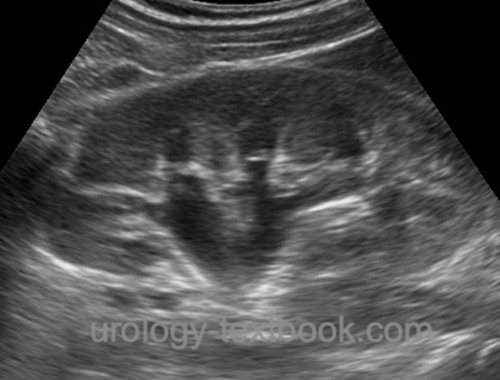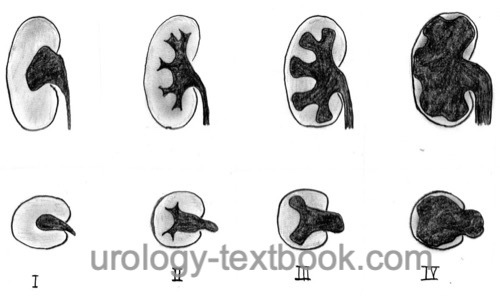You are here: Urology Textbook > Signs and symptoms > Hydronephrosis
Hydronephrosis and Upper Urinary Tract Obstruction: Differential Diagnosis
Definition of Hydronephrosis
Upper urinary tract obstruction results in urinary stasis and pressure increase in the kidney. It may lead to urinary tract infection and urosepsis and if long-lasting, there is a risk of renal insufficiency.
- Obstructive nephropathy or uropathy: renal dysfunction due to obstruction of the urinary tract, the pathological changes are characterized by inflammation, tubular atrophy and interstitial fibrosis.
- Hydronephrosis: descriptive term, Greek meaning water (hydro) in kidney (nephros): dilatation of the renal pelvis and/or calyces. Hydronephrosis can be present without relevant obstruction.
Grading of Hydronephrosis
- Grade I: dilatation of the renal pelvis \textit{without} dilatation of the calyces, no parenchymal atrophy.
- Grade II: dilatation of the renal pelvis and calyces without parenchymal atrophy (sharp-edged calyces with prominent papillary impression).
- Grade III: prominent dilatation of the renal pelvis and the renal calyces with signs of organ atrophy: flattening of papillae and blunting of calyces.
- Grade IV: massive dilatation of the renal pelvis and renal calyces, loss of borders between renal pelvis and calyces. Almost complete atrophy of the renal parenchyma (hydronephrotic sac).
 |
Differential diagnosis of Hydronephrosis
Urinary retention:
- Prostate diseases: benign prostatic hyperplasia, prostate cancer, prostatic cyst.
- Bladder diseases: bladder tumors, bladder stones, bladder neck sclerosis, detrusor sphincter dyssynergia (DSD).
- Diseases of the urethra: urethral stricture, carcinoma, foreign bodies, phimosis, urethral valves.
- Medication, alcohol, postoperative urinary retention, diabetes mellitus.
Ureter diseases causing hydronephrosis (intrinsic causes):
- Ureteral stone
- Ureteral clot due to hematuria
- Congenital diseases: ureteropelvic-junction obstruction, vesicoureteral reflux, megaureter, ureterocele, megacalicosis, calyceal diverticula.
- Benign ureteral stricture: after ureteral stone therapy, infection (tuberculosis, schistosomiasis), idiopathic.
- Ureteral cancer
Iatrogenic Causes of Hydronephrosis:
- Intraoperative injuries: ureteroscopy, rectal surgery, hysterectomy, vascular surgery. The spectrum of injury ranges from ischemic strictures due to coagulation to complete transection and ligature.
- Irradiation, radiation injury of the bladder trigone
Hydronephrosis due to Vascular Diseases:
- Aortic aneurysm
- Renal artery aneurysm
- Aneurysm of the iliac vessels
- Retrocaval ureter or retroiliac ureter
- Postpartal ovarian vein thrombophlebitis: 1/3000 pregnancies, may cause hydronephrosis.
Gynecological Diseases Causing Hydronephrosis:
- During pregnancy, the enlarged uterus can compress the ureter (right side more often than left side) and may cause pyelonephritis during pregnancy.
- Endometriosis: recurrent flank pain, dysuria, hematuria
- Extra-uterine pregnancy
- Tuboovarial abscess
- Pelvic floor insufficiency with organ prolapse
- Tumors: cervical cancer, ovarian cysts, ovarian cancer, uterine leiomyoma ...
Hydronephrosis caused by Diseases of the Retroperitoneum:
- Retroperitoneal tumors: lymphoma, retroperitoneal sarcoma, retroperitoneal (metastasis of) germ cell tumors.
- Lymph node or distant metastases: prostate cancer, cervical cancer, breast cancer, colon cancer, stomach cancer, bladder cancer, ....
- Retroperitoneal fibrosis
- Pelvic lipomatosis : rare disease with pelvic fat accumulation and cranial displacement of bladder and ureters.
Diagnostic Workup in Hydronephrosis
 |
- Laboratory tests: urine analysis (sediment microscopy), serum electrolytes and creatinine.
- Sonography of kidney and ureter (see above).
- Intravenous urography or computed tomography of the abdomen (with or without contrast medium) or abdominal MRI.
- Renal scintigraphy: to differentiate between relevant obstruction or dilatation of the calyceal system without obstruction. Renal scintigraphy can determine renal function and the need for surgical interventions.
- Retrograde pyelography and ureterorenoscopy: necessary for diagnosis and treatment of upper urinary tract obstruction (ureteral stenting, ureterotomy).
| Hydronephrosis | Index | Groin lumps |
Index: 1–9 A B C D E F G H I J K L M N O P Q R S T U V W X Y Z
References
Gleason, P. E.; Kelalis, P. P.; Husmann, D. A. &
Kramer, S. A.
Hydronephrosis in renal ectopia: incidence, etiology and
significance
J Urol, 1994, 151, 1660-1
 Deutsche Version: Differentialdiagnose Harnstau
Deutsche Version: Differentialdiagnose Harnstau
Urology-Textbook.com – Choose the Ad-Free, Professional Resource
This website is designed for physicians and medical professionals. It presents diseases of the genital organs through detailed text and images. Some content may not be suitable for children or sensitive readers. Many illustrations are available exclusively to Steady members. Are you a physician and interested in supporting this project? Join Steady to unlock full access to all images and enjoy an ad-free experience. Try it free for 7 days—no obligation.
New release: The first edition of the Urology Textbook as an e-book—ideal for offline reading and quick reference. With over 1300 pages and hundreds of illustrations, it’s the perfect companion for residents and medical students. After your 7-day trial has ended, you will receive a download link for your exclusive e-book.